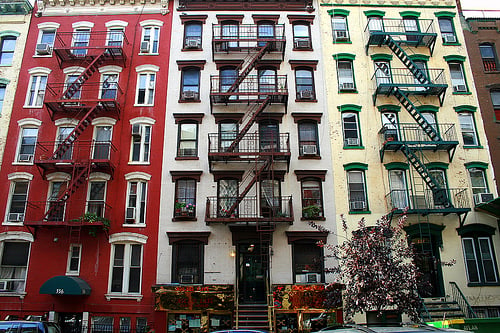Housing costs depriving U.S. economy of billions
Regulations on new housing — and the resulting shortfall in supply — are costing the U.S. economy billions each year. How? A new study, “Why Do Cities Matter? Local Growth and Aggregate Growth” by Chang-Tai Hsieh of the University of Chicago and Enrico Moretti of UC Berkeley, finds that income disparity in metro areas is directly impacted by housing costs, costing the country billions yearly, or a loss of 10% of the country’s economy.

To 95% of the country, these apartments in New York City’s East Village look like dense development. Two economists caution that it’s not nearly dense enough. Image from echiner1.
It’s a fact that those with similar skills and education levels will earn more money in San Francisco or New York than in Cleveland or St Louis, but over time, these income disparities would even out as workers move from low-income cities to high-income cities in search of opportunities… right? Not according to the study, which shows that over the last 50 years, the difference in incomes among metro areas has been on the rise.
As Vox reports, “It’s not hard to figure out why people aren’t moving. While the wage difference between St. Louis and San Francisco is large, the difference in housing costs is even bigger. A programmer in St. Louis might get a big raise by moving to San Francisco to take a job at a technology company there, but he might still be left worse off thanks to the much higher rents there.” Higher costs for housing may be discouraging people from accepting higher-paying jobs in more expensive cities.
Calculating the impact of restrictive housing regulations in San Francisco, San Jose, and New York, the study envisioned the U.S. housing markets becoming more elastic, where higher demand for housing results in increased construction, and not increased rents. Their work suggests that if coastal cities like New York, Washington, Boston, Seattle, and the San Francisco Bay Area had more affordable housing, more workers would flock there. Additionally, their data implies that “workers in these cities are more productive than in other metropolitan areas,” even when controlling for factors like education, reports Vox.
The study authors estimate that moving workers to higher-productivity cities could result in a staggering $1 trillion boom in American workers’ incomes, or several thousand dollars for every worker. The reality is, however, that the changes they imagine are impossible; New York’s metro area, for instance, would have to grow nine times its existing size to house more than half of the country’s workers. The San Francisco Bay Area would quadruple, and half of American cities would lose 80% or more of their current population. (Consider Flint, Michigan, which would drop from 102,000 residents to just 2,000.)
While these imaginings won’t, and likely cannot, happen, they do raise interesting questions about the impact of housing restrictions on the economy. How can we make housing more affordable? As Vox notes, there are two policies that could potentially create big change:
- The government could provide funds or discounted housing to low-income families; and
- Policymakers could raise the number of residences in a particular metro area by either easing restrictions on building sizes, or by easing restrictions on minimum sizes of individual units.
Related Posts
Category: Infrastructure, Miscellaneous

















